Bergamo knows how to surprise you in a thousand ways, and one of the least known is perhaps just how rich it is in nature. The richness of the Orobie Pre-Alps, the countryside and seven hills at the foundations make her a true lady dressed in green. The Upper Town has also been part of a protected area - the Parco dei Colli - since 1975, whose paths branch off to the neighbouring municipalities.
Do you want to explore the naturalistic side of Bergamo without missing out on historical beauties, panoramas and little secrets such as its medieval stairways? Take this round trip and you won't regret it!
Bergamo knows how to surprise you in a thousand ways, and one of the least known is perhaps just how rich it is in nature. The richness of the Orobie Pre-Alps, the countryside and seven hills at the foundations make her a true lady dressed in green. The Upper Town has also been part of a protected area - the Parco dei Colli - since 1975, whose paths branch off to the neighbouring municipalities.
Do you want to explore the naturalistic side of Bergamo without missing out on historical beauties, panoramas and little secrets such as its medieval stairways? Take this round trip and you won't regret it!

The first section takes you from S. Alessandro Gate to San Vigilio Hill, which has always watched over the city and the surrounding plain. You can reach it on foot by going up from Via San Vigilio or by travelling on the city’s second historic funicular, that of San Vigilio. Both routes are very scenic. The choice is yours!
Since you are at the beginning of a moderately demanding route, we recommend the funicular. Once you reach the upper station, turn right and go up the cobbled street to San Vigilio Castle. From the homonymous park, which houses the historic ruins, you will have a breathtaking view of the north side of Bergamo.
Once you go back down Via al Castello, pass the funicular and a little further on you will enjoy a second wonderful panorama, the one from the terrace of the Church of San Vigilio.
POI
The first section takes you from S. Alessandro Gate to San Vigilio Hill, which has always watched over the city and the surrounding plain. You can reach it on foot by going up from Via San Vigilio or by travelling on the city’s second historic funicular, that of San Vigilio. Both routes are very scenic. The choice is yours!
Since you are at the beginning of a moderately demanding route, we recommend the funicular. Once you reach the upper station, turn right and go up the cobbled street to San Vigilio Castle. From the homonymous park, which houses the historic ruins, you will have a breathtaking view of the north side of Bergamo.
Once you go back down Via al Castello, pass the funicular and a little further on you will enjoy a second wonderful panorama, the one from the terrace of the Church of San Vigilio.
POI
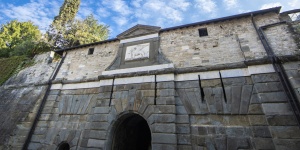
Sant’Alessandro is the name of the gate facing west, which used to be the main access to the city for those who came from Lecco and Como. Its name comes from the near church dedicated to Bergamo’s patron Saint, destroyed in 1561, as shown by a commemorative plaque located next to the only surviving column, in order to build the Walls. If you cross the gate you can still find the “Sant’Alessandro’s Column”, marking the exact spot where the old cathedral used to be.
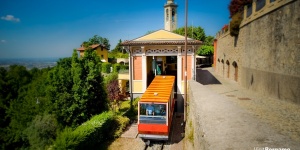
If you have already taken the first funicular and reached Piazza Mercato delle Scarpe in the Upper Town, don’t stop your climb: go and try out the second one, to visit the San Vigilio hill!
This system leads you to a less-popular part of the city, worthy of being visited as it’s surrounded by nature and represents the perfect starting point for a walk across the wonderful “Parco dei Colli –Hills Park”, a protected green area of 4,700 hectares. It was inaugurated on August 27th 1912 and designed by Alessandro Ferretti, one of the best Italian engineers of that time, who planned tens of funicular railways and realized about 15 of them.
San Vigilio funicular covers 630 meters, with a 90 m difference in height and a slope going from 10% to 22%, which lets you enjoy a stunning view of the hills and the plain.
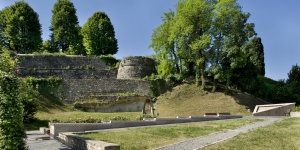
Representing a clearly visible symbol of power, San Vigilio Castle has been the residence of Bergamo’s numerous rulers for centuries. It is located 496 meters above the sea level, on top of the hill that gives it its name, overlooking the Città Alta: that’s why it used to have a strategic role in case of attacks. From its top, you can see the Mount Bastia nearby and the villages of the old Breno valley (called Valbrembo and Paladina today), along with the Almenno plain, also known as Lemine, once renowned for being an important trade centre, and the hamlets located all along the street leading to the Brembana valley. This spectacular and vast landscape also embraces a significant part of the pre-Alps. The circle plan of the building resembles a star, featuring the four towers called Castagneta, Belvedere, Del Ponte and San Vigilio. Its basements are very tortuous: a tunnel (accessible in part) was also found, connecting the Castle directly to the northern side of the hills fortification, inside the San Marco Fortress.
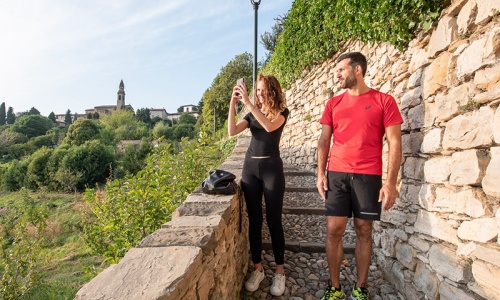
The next stop on your itinerary is at the base of the Scorlazzone, one of the gallettato stairways (paved with broken stones typical of mountain villages) which in the Middle Ages represented the main link between Upper and Lower Bergamo. Take the alley to the right of the Church of San Vigilio and immerse yourself in a timeless atmosphere, among historic houses, gardens and fascinating views.
At the end, turn right and walk down a stretch of Via Sudorno: a little further on, another small hidden treasure awaits you, the Tempio dei Caduti (Memorial Temple). Built in 1915 on the remains of the ancient church of S. Maria di Sudorno (of which it retains the altarpiece), it is dedicated to the soldiers of the First World War.
POI
The next stop on your itinerary is at the base of the Scorlazzone, one of the gallettato stairways (paved with broken stones typical of mountain villages) which in the Middle Ages represented the main link between Upper and Lower Bergamo. Take the alley to the right of the Church of San Vigilio and immerse yourself in a timeless atmosphere, among historic houses, gardens and fascinating views.
At the end, turn right and walk down a stretch of Via Sudorno: a little further on, another small hidden treasure awaits you, the Tempio dei Caduti (Memorial Temple). Built in 1915 on the remains of the ancient church of S. Maria di Sudorno (of which it retains the altarpiece), it is dedicated to the soldiers of the First World War.
POI
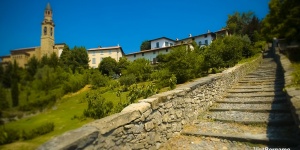
The most particular and “local” way to move from Lower to Upper Bergamo is the “scalette”, our ancient flights of stone steps. They are exclusively pedestrian pathways, paved with the typical cobblestones.
Their steps climb up to the Upper Town, bordered by old dry stone walls, crossing fields, terraced gardens and beautiful mansions: with every step you’ll take, a new amazing landscape will appear. However, the “scalette” are also a beloved place for runners to workout, being far from the traffic, quiet and charming.
The Scorlazzone is the natural continuation of the Scorlazzino, which climbs up from the Lower Town, and with its flat, but sloped 162 steps it's also one of the most demanding.
If you are in Sudorno street, look for the small water fountain that can be found under a protective arch, ascend the short slope over it and you will find the scaletta. A veritable journey into the past!
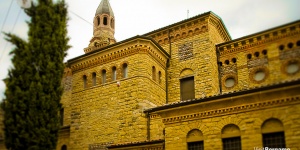
Built on the ruins of the ancient church of S. Maria di Sudorno, destroyed specifically for its construction in 1915-16, the temple is also known as the church of Sudorno, named after the street where it stands and under which one of the two ancient Roman aqueducts ran.
Dedicated to the victims of war, the altar-piece of the old medieval church is housed inside (covered entirely with dark marble).
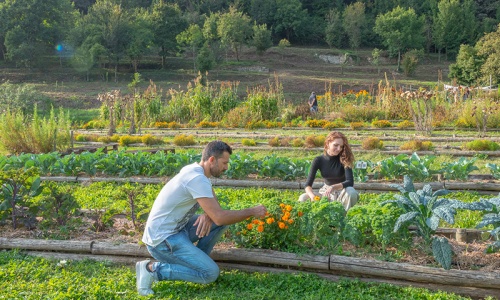
From the Temple continue to the bend beyond the portico and turn right onto Via Astino. Here begins a new panoramic stretch that will reveal to you step by step wooded parks, vineyard covered hills and, in the distance, the valley with the Bosco dell'Allegrezza, which houses the ruins of a castle. At the second last bend, you also come across the beautiful, recently restored stairway in Via Lavanderio.
The Astino Valley then opens up before you in all its beauty: here you’ll find the former Astino Monastery, which in the summer comes alive with events and excellent food and wine; as well as the Church of the Holy Sepulchre with its magnificent artworks and, opposite, the Biodiversity Valley, an oasis of conservation of local flora which houses a section of Bergamo’s Botanical Garden.
POI
From the Temple continue to the bend beyond the portico and turn right onto Via Astino. Here begins a new panoramic stretch that will reveal to you step by step wooded parks, vineyard covered hills and, in the distance, the valley with the Bosco dell'Allegrezza, which houses the ruins of a castle. At the second last bend, you also come across the beautiful, recently restored stairway in Via Lavanderio.
The Astino Valley then opens up before you in all its beauty: here you’ll find the former Astino Monastery, which in the summer comes alive with events and excellent food and wine; as well as the Church of the Holy Sepulchre with its magnificent artworks and, opposite, the Biodiversity Valley, an oasis of conservation of local flora which houses a section of Bergamo’s Botanical Garden.
POI
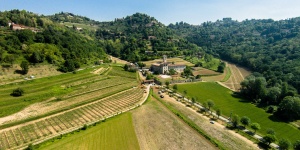
Located between the Bosco dell’Allagrezza (the “Cheerfulness Wood”) and the Benaglia Hill, the Astino Valley immediately conveys a sense of piece and serenity. That’s why in 1170 the vallombrosan monks decided to build their monastery and the Santo Sepolcro here.
A tight boundary was established between these religious buildings and the territory, to the extent that the name “Astino” indicates both the valley and the historical complex. In this little piece of heaven, space and time merge into something eternal.
Sit on the wide meadow surrounding this site: the beauty and the calm of the landscape will amaze you. Forests, hills and fields almost hide the network of streets all around the monastery: eastwards to the district of Longuelo, Bergamo, westward to the San Martino valley, heading north to San Sebastiano and the Bastia and San Vigilio hills.
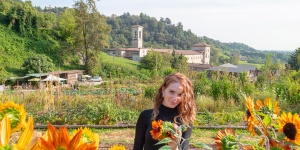
The Astino section of Bergamo’s Botanical Garden aims to answer this question, by opening the wonderful natural district of Astino and inviting everyone to learn a little bit more about biodiversity and agricultural biodiversity.
From May to October, you will have the great opportunity to walk across the 1.000 types of plants growing in the Astino section of Bergamo’s Botanical garden.
You can find every vegetal variety used by Man throughout his history, belonging to more than 300 species. This invaluable treasure has been set up in order to let people know what biodiversity and agrobiodiversity are, in a beautiful agricultural and forestry area: Astino.
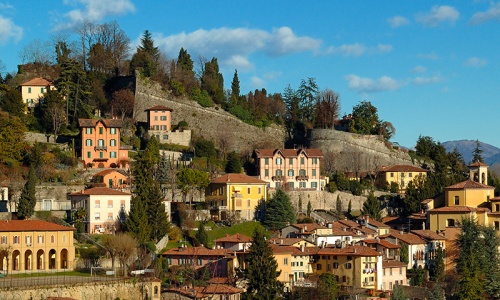
Filled up on nature? It's not over yet! To complete the itinerary, continue along Via Astino skirting the fields of the Linificio e Canapificio Nazionale, which in spring-summer are transformed into an expanse of flax flowers. At the end, you will find a pedestrian crossing and you can take the path that runs alongside the Roggia Curna, part of the great irrigation system built in 1475 by Bartolomeo Colleoni.
The path ends up on Via Ripa Pasqualina: turn left and start the climb. Soon the narrow street turns into a medieval stairway, giving you something beautiful to look at - and a great cardio workout!
At the top, at the crossroads with Via San Martino, go straight on for a few minutes and you will soon reach the delightful little church of S. Martino della Pigrizia. Then another crossroads awaits you, this time with the San Martino Stairway on the right (for next time) and the Scorlazzino on the left. Take it, go up for a short, picturesque detour and immediately go back down Via San Martino. From here, turning left again, you very soon reach Via Borgo Canale and another historic church, S. Erasmo.
POI
Filled up on nature? It's not over yet! To complete the itinerary, continue along Via Astino skirting the fields of the Linificio e Canapificio Nazionale, which in spring-summer are transformed into an expanse of flax flowers. At the end, you will find a pedestrian crossing and you can take the path that runs alongside the Roggia Curna, part of the great irrigation system built in 1475 by Bartolomeo Colleoni.
The path ends up on Via Ripa Pasqualina: turn left and start the climb. Soon the narrow street turns into a medieval stairway, giving you something beautiful to look at - and a great cardio workout!
At the top, at the crossroads with Via San Martino, go straight on for a few minutes and you will soon reach the delightful little church of S. Martino della Pigrizia. Then another crossroads awaits you, this time with the San Martino Stairway on the right (for next time) and the Scorlazzino on the left. Take it, go up for a short, picturesque detour and immediately go back down Via San Martino. From here, turning left again, you very soon reach Via Borgo Canale and another historic church, S. Erasmo.
POI
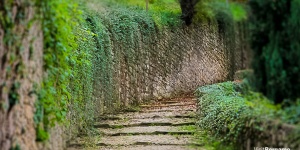
The slope can be reached from the corner of a tower house, overlooking via Astino.
The initial path is rather flat. However, beyond via del Celtro (from the dialect term "selter" and the Latin word "ciltrum"Â_x009d_, meaning "arch"), it becomes narrower and slightly more steep, until it turns into a paved flight of steps that ends on a paved road that connects to via Sudorno (a place name that refers to the medieval cult of the god Saturn).
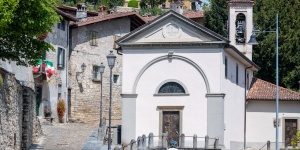
Along the panoramic route that climbs from the Longuelo neighbourhood to Borgo Canale, between Bergamo’s two marvellous basins, that of Astino and the Conca d'Oro, you will come across the small Church of San Martino della Pigrizia along the way.
Contrary to what one might think, San Martino has nothing to do with laziness, pigrizia meaning laziness, far from it! The name of this place derives from a purely geographical issue: the part of land on the side of the Astino Valley, unlike that of the Conca d'Oro, is by nature less exposed to the sun's rays and for this reason the crops in this area proceed more slowly. Over time, the locals began to assign "La Pigrizia" as a nickname for this portion of land, precisely underlining its 'lazy' character.
The church, which has arrived to the present day from the 9th century not without various alterations, has a main entrance in bronze on which the two patron saints are sculpted: San Martino and Madonna della Purità and a small upper lunette which completes the arched opening of the facade. Laterally, a small stone staircase leads to the secondary entrance door. It too is in bronze and depicts the history of the small church. The interior consists of a single rectangular nave divided into three bays by two masonry arches, onto which the two pitches of the exposed roof unload. The presbytery consists of a very simple chapel covered by a barrel vault with some artworks in the centre representing the Madonna and Child with Saints Martino, Giovan Battista, Carlo and Antonio of Padua.

The most particular and “local” way to move from Lower to Upper Bergamo is the “scalette”, our ancient flights of stone steps. They are exclusively pedestrian pathways, paved with the typical cobblestones.
Their steps climb up to the Upper Town, bordered by old dry stone walls, crossing fields, terraced gardens and beautiful mansions: with every step you’ll take, a new amazing landscape will appear. However, the “scalette” are also a beloved place for runners to workout, being far from the traffic, quiet and charming.
The Scorlazzone is the natural continuation of the Scorlazzino, which climbs up from the Lower Town, and with its flat, but sloped 162 steps it's also one of the most demanding.
If you are in Sudorno street, look for the small water fountain that can be found under a protective arch, ascend the short slope over it and you will find the scaletta. A veritable journey into the past!
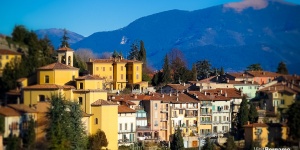
It’s one of the most panoramic sites of the city. You can enjoy a breath-taking view of the flatland from one side, and an unusual view of Città Alta from the other, admiring its amazing towers, belfries and domes.
This corner of Bergamo is an oasis of peace and romance, indeed, where you can stop and stare at the landscape without being bothered by traffic, or you can walk down the old narrow alleys.
Moreover, in one of these streets the famous composer Gaetano Donizetti was born.
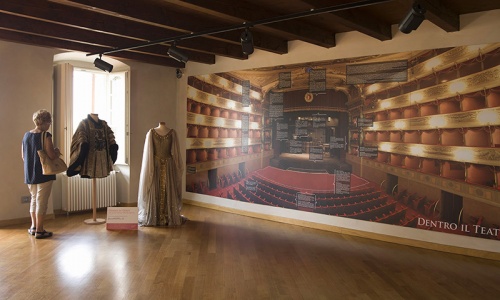
Welcome to Borgo Canale, the historic district of vegetable gardens and artists! Here, at number 14, Bergamo’s composer Gaetano Donizetti was born in 1797, and it is precisely the home of his family that now houses the Museum of Donizetti's Birthplace. But before reaching it, there is still a stretch of road waiting for you, along which you come across a new church: the eighteenth-century Santa Grata Inter Vites, dedicated to Bergamo’s patron saint and decorated by Bonomini. The particular attribute refers to its position, once in the open countryside cultivated with vines.
Arrived at the top of Via Borgo Canale, here is the starting point, Largo di Porta S. Alessandro.
POI
Welcome to Borgo Canale, the historic district of vegetable gardens and artists! Here, at number 14, Bergamo’s composer Gaetano Donizetti was born in 1797, and it is precisely the home of his family that now houses the Museum of Donizetti's Birthplace. But before reaching it, there is still a stretch of road waiting for you, along which you come across a new church: the eighteenth-century Santa Grata Inter Vites, dedicated to Bergamo’s patron saint and decorated by Bonomini. The particular attribute refers to its position, once in the open countryside cultivated with vines.
Arrived at the top of Via Borgo Canale, here is the starting point, Largo di Porta S. Alessandro.
POI
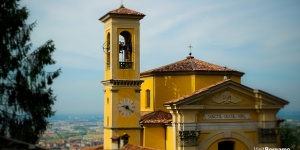
The Church is dedicated to Saint Grata, Bergamo’s co-patron, and it’s the first place where the Saint was buried, till the year One Thousand: later it was moved to the other church with the same name, in via Arena, inside the Walls perimeter.
Dating back to the XIV Century, this building was destroyed two hundred years later to make room to the Walls. Afterwards, it was erected back in the XVIII Century.
If you’re wondering what does “inter vites” mean, you should know that the church used to be surrounded by vineyards, which disappeared in the XVIII Century.
In front of the church you can admire the majestic St Gottardo Stairway, named after the ancient monastery demolished in 1798.
Inside the building you will find a frescos cycle called “Living skeletons scenes” (“Scene di scheletri viventi”), painted by the artist Paolo Bonomini in the XIX Century. During that time, it was considered as an extremely edgy artwork, as the skeletons resembled some actual people living in the borough: a carpenter, two praying friars, a couple of newlyweds, a Cisalpine Republic tambourine and even the artist himself, next to his wife.
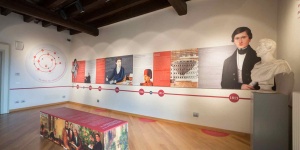
With these words, one of the 5 most famous music composers of all times described his family’s first house, in a letter he wrote to Simone Mayr.
Donizetti’s birthplace, a national historic site, is here in Bergamo, in via Borgo Canale, where buildings used to be extremely poor and crumbling.
His family lived in the basement of a building whose ground floor can also be visited today, where you entered by means of a narrow staircase. It was a very humble house, consisting of two rooms - kitchen and bedroom - along with a well and an icehouse.
It seems that Donizetti’s destiny was written in the stars: over his life, he interlaced music notes creating immortal compositions, just like his parents used to intertwine fabrics. In fact, the Master’s parents were both tailors and were part of that humble people earning their living by working for the noblemen of the Upper Town. Donizetti managed to redeem its humble beginnings becoming famous all over the world and bringing prestige to his city.

Sant’Alessandro is the name of the gate facing west, which used to be the main access to the city for those who came from Lecco and Como. Its name comes from the near church dedicated to Bergamo’s patron Saint, destroyed in 1561, as shown by a commemorative plaque located next to the only surviving column, in order to build the Walls. If you cross the gate you can still find the “Sant’Alessandro’s Column”, marking the exact spot where the old cathedral used to be.
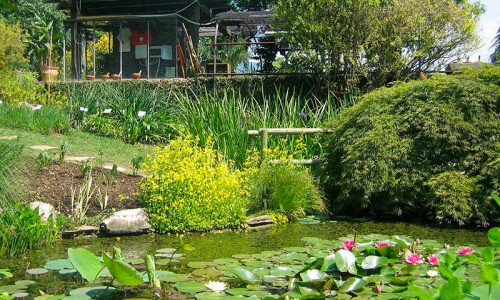
One stage is still missing, no less green than the others: the “Lorenzo Rota” Botanical Garden. Go past S. Alessandro Gate, turn left and walk along Via Costantino Beltrami up to the traffic lights; here you can cross the road and face the last climb of the day, Scaletta Colle Aperto, which flanks the historic San Marco Gunpowder Magazine. Along the way, you will come across more and more perfumes and soon you will be able to enjoy the wonderful garden. It's worth it!
Want to experience this marvellous itinerary, but reversed? No problem, it's a ring route, so you can start it from any of its points of interest.
Enjoy your walk!
POI
One stage is still missing, no less green than the others: the “Lorenzo Rota” Botanical Garden. Go past S. Alessandro Gate, turn left and walk along Via Costantino Beltrami up to the traffic lights; here you can cross the road and face the last climb of the day, Scaletta Colle Aperto, which flanks the historic San Marco Gunpowder Magazine. Along the way, you will come across more and more perfumes and soon you will be able to enjoy the wonderful garden. It's worth it!
Want to experience this marvellous itinerary, but reversed? No problem, it's a ring route, so you can start it from any of its points of interest.
Enjoy your walk!
POI
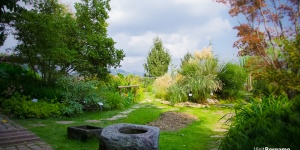
The 2,400 square metre gardens are home to over 1,200 types of plants, the majority of which in micro-habitats, which replicate or imitate their natural environments.
The gardens are only accessible by foot from a staircase of 141 steps, offering a unique panorama with sweeping views over the Upper Town’s rooftops and monuments and the first offshoots of Bergamo’s Alpine foothills.
http://www.ortobotanicodibergamo.it/